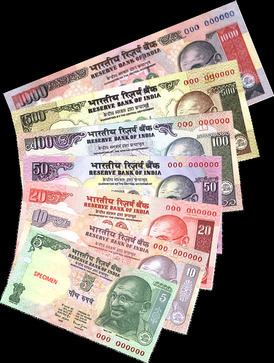 | ||
The Gandhi Series of banknotes are issued by the Reserve Bank of India (RBI) as the legal tender of Indian rupee. As the name suggests, the series is so called because the obverse of the banknotes prominently display the portrait of Mahatma Gandhi. Since its introduction in 1996, this series replaced all banknotes issued before 1996. The Reserve Bank of India (RBI) introduced the series in 1996 with 10 and 500 rupee banknotes.
As of 10 November 2016, the RBI issues banknotes in this series in denominations from ₹5 to ₹100. Printing of five-notes, which had stopped earlier, restarted in 2009. On 8 November 2016, the ₹500 and ₹1000 banknote denominations of this series were demonetized and the new Mahatma Gandhi New Series of banknotes were revealed in denominations of ₹500 and ₹2000, intended to replace this series.
Security features
The following features are included in the notes.
- An intaglio (raised) shape is present on all denominations other than the ₹10 note to help the visually impaired.
- ₹20-Vertical rectangle
- ₹50-Square
- ₹100-Triangle
- ₹500-Circle
- ₹1,000-Diamond
- ₹2,000-Horizontal rectangle
- The image of Mahatma Gandhi, Reserve Bank of India seal, clause of guarantee, Ashoka Pillar emblem and signature of the governor of the Reserve Bank of India are all intaglio prints.
